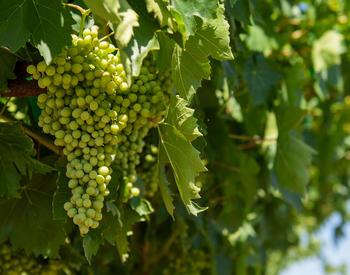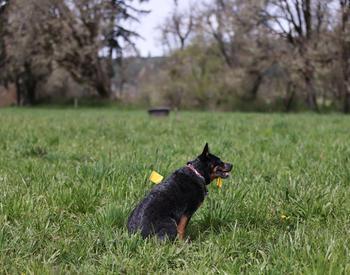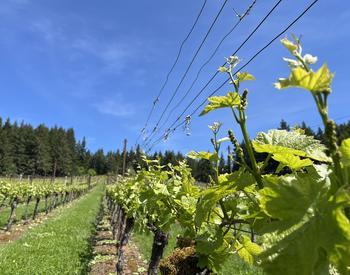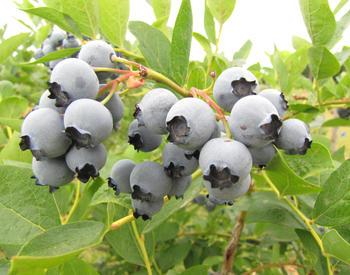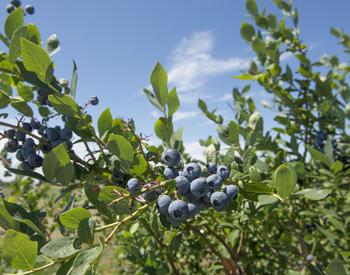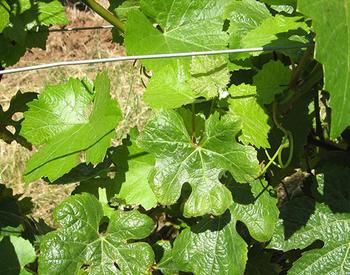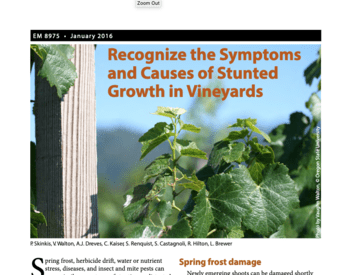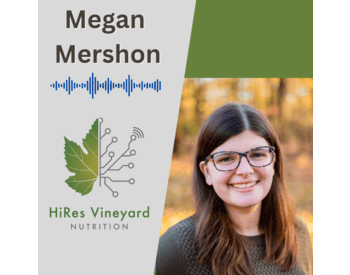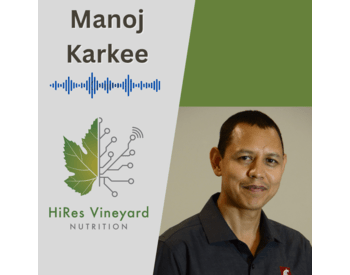Transcript
(00:00:00) Patty Skinkis
This is the High-Res Vineyard Nutrition Podcast, devoted to helping the grape and wine industry understand more about how to monitor and manage vineyard health through grapevine nutrition research. I am your host, Dr. Patty Skinkis, Professor and Viticulture Extension Specialist at Oregon State University.
(00:00:22) Patty Skinkis
Vineyard research is important to advancing the industry throughout the US, and Viticulture research, in particular, is most commonly conducted at Land-grant institutions throughout the United States by researchers, like myself, who receive funding from grants. These grants may be from private industry sources, such as the American Vineyard Foundation, or from State or Federal funds. How research questions are developed, funded and executed is something that academics, like myself, are fully aware of. After all, that's what we do. However, many members of the industry or the public are not likely to be fully aware of the process, and the High-Resolution Vineyard Nutrition Project is a Federally-funded project. I've invited Dr. Russ Smithyman to join us today to discuss how this project came to fruition. Russ earned a PhD in Horticulture from Washington State University and a Master’s of Science in Horticulture from Michigan State University. He's a midwesterner, like myself. He worked for more than 20 years for St. Michelle Wine Estates in Prosser, Washington as Director of Viticulture and, before that, Director of Research. He's well known for his industry expertise in viticulture production and mechanization applications to improve Viticulture for the wine grape industry. Currently, Russ is the Chair of the Board for the National Grape Research Alliance, or NGRA, where he had a leading role in developing the nationwide research project focusing on mineral nutrition of vineyards, now known as the High-Resolution Vineyard Nutrition Project.
Thanks for joining us today, Russ, and as we get started, I wanted to just let the audience know more about NGRA: Why was it developed and what is it?
(00:02:10) Russ Smithyman
A pleasure to be here, Patty, and thank you for the invitation. NGRA is a National Grape Research Alliance and if you go to the website, the website describes it as an industry-driven, non-profit organization that works to align research priorities at the highest level to strengthen the competitiveness of America's grape industry. I'd kind of like to think of it, though, as a sort of a “National Think Tank,” if you will, for grape research. NGRA wants to be the voice for grape research nationally, representing all grape industries: wine grapes, juice grapes, table grapes and raisins. They want to focus on large issues that could not be addressed locally or regionally or by any specific commodity of those 4 commodities I just listed. Really, the goal was to try to reduce the duplication of research, and this is really what the strength, I think, of NGRA is--trying to help researchers solve some of the major issues that the grape industries face in today's world.
(00:03:08) Patty Skinkis:
The group of NGRA at least, for me, is very interesting because a lot of times at the academic institutions we kind of work with who's in our institution or who we're familiar with locally or regionally and it's hard to get beyond that. So, just having that kind of force to be able to help collaborate between different institutions has been great. So, can you tell us a little bit about how you became involved?
(00:03:38) Russ Smithyman
I was involved in sort of the inception of NGRA back in the early 2000’s. NGWI, the National Grape and Wine Initiative, was developed in 2006, and so, prior to that, there was a few years of trying to figure out how could we come together the different grape industries--not only the different commodity groups, but the different states and regions to really strengthen grape research overall. So, I became involved. I've always been very passionate for research and the company, St. Michelle Wine Estates, that I worked for. Originally, I was the Director of Research there, so that was my background and I really wanted to support not only research that we did, but what also the Universities did, and really, NGRA, it tries to identify issues or problems within the grape industries and then tries to drive or support the projects, like you said, until fruition. It is a little bit different than the typical research development, in that NGWI tries to identify some of the major problems, like I said, that couldn't be addressed locally, and then try to help researchers or design a research team to address those problems. And not only selecting some of the researchers, but also then supporting that research through funding. Whether it be through grants, as this project is, like I said, funded federally through an SCRI grant, Specialty Crop Research Initiative, or by private donations. So, that's really what really drove me and really excites me about NGRA.
(00:05:10) Patty Skinkis:
The NGRA board member positions are volunteer, correct? They're not paid positions?
(00:05:17) Russ Smithyman
No, they're volunteer positions but to become a member there is a donation that is required.
(00:05:24) Patty Skinkis:
Okay, and so and it's not a funding organization – Correct?
(00:05:28) Russ Smithyman
No. Although, they have, through some of the resources that they've acquired through these donations, funded some things initially to get them off the ground or to get supporting research or information that could then support a larger grant, Per se. But for the most part, we're trying to facilitate research and drive some of these bigger projects that couldn't really be done in a smaller scale.
(00:05:52) Patty Skinkis:
So, I think that's a good segue to my next question. I know because I was on the committee that helped come up with this question, but how was vineyard nutrition determined as the focus of a research effort? And maybe you can talk a little bit about the specific committee groups that were working on research topics.
(00:06:12) Russ Smithyman
Yeah, so that's a great question because for the initial first ten years of NGWI, before NGRA was declared, there wasn't a whole lot being done through the different committee processes. Yes, NGWI did support some major projects, the Efficient Vineyard Project and some others, but it was in 2016 when we decided to sort of re-develop the different research committees that kind of come up with these different ideas for projects. Prior to 2016 I was on a committee called the Quality Committee and we languished for seemed like every year trying to figure out different aspects of quality. Quality is so subjective. Different aspects to research in 2016 we sort of scrapped that whole idea around quality and really made more specific different committee groups. The particular committee that I chair is the Integrated Vineyard Production Systems Committee. I affectionately call it the “Tools Committee” because that's when during my committee process we were trying to brainstorm new things. I asked the committee, “Do you know what is the next tool? Or a tool that you could use in the future that would really help you in producing your grapes?” So, in 2016 we came up with these different committees again, the Integrated Venue Production Systems, there's also a Natural Resources Committee that looks at problems around the natural resources. There's a Genetics Committee and then there's also the Extension Committee that really supports academic research extension throughout the country. In 2017 a committee was developed for the Integrated Vineyard Production Systems, and then 2018 this committee met and through the summer of 2017 to 2018 is when we kind of brainstormed what these next projects might be and really to be honest, with you nutrition was maybe not the highest one. At least it wasn't in my mind. We had mechanization, irrigation management, pest management, fruit quality, disease management and really, the I call the “Holy Grail,” is a crop estimation work that that was initiated. These are all very important to large scale projects and topics and issues that we felt were very necessary for grape industries in the future. Nutrition was really the one that was settled on because the committee wanted to sort of hit a home run off the bat. They wanted to come up with something that was going to be well-supported by all the different commodity groups and supported regionally throughout the country and nutrition was that perfect project. It was something that every commodity group, whether it be raisins, wine grapes, table grapes or Juice grapes could benefit from. All portions of the country, wherever grapes are grown, could benefit from it. Grapes are the most widely grown commodity or production with agricultural production within the country. And so, nutrition was something that would really hit home and really be successful for anyone growing grapes. So that was really the reason why nutrition was selected as one of, as well, the first topic. Now, to follow that up, since then we've started a new issue or topic, and that’s the fruit quality. Again, that's another one that could be well-supported throughout the different commodity groups and the country, but nutrition was the first one. Hopefully we'll see the same sort of success with the with fruit quality type of sensor in the future as well.
(00:09:35) Patty Skinkis:
NGRA had this ability to at least brainstorm initially the development of the topic. And then, of course, came the next step because I was also on that committee, was finding the researchers to do the work and to come up with a proposal. So, can you talk a little bit more about how that group of researchers was comprised?
(00:09:57) Russ Smithyman
You have to remember that we were all going through this for the first time back in 2017, 2019, through this process, so we'd never done this before. So what NGRA wanted to do is not only select a topic, but then who were the best researchers that could really accomplish and or solve this issue in a short period of time. And so that we came up with a list of different researchers from around the country and the different commodity groups, whether it be table grapes again or wine grapes, et cetera. And Dr. Markus Keller was one that was close to top. He's a world-renowned grape researcher and he was an obvious choice. He happened to have his office about a mile away from my home, so he was an easy one to go chew on his ear a little bit, get his ideas on the particular topic. After my first meeting with him he was obviously very interested. He had time and some resources to devote to this project so he was one that was sort of an easy one to ask to participate and eventually lead this particular project. From there, we, NGRA likes to allow the lead or the principal investigators to really select their team. Who are they going to work well with? Not everybody works well together. We understand that, so we wanted to allow Markus to really select his team. Again, we had a list of researchers that we thought would benefit the team, but in the end, Markus is the one that really selected this great team. With through the guidance of NGRA again, we wanted not just somebody or a group from Washington State University. We recognize that we need to have members from California, members from the East Coast, the Southwest, wherever grapes are grown to some scale. So Markus did a great job at putting together a team that addressed all these types of issues and he's very open to what NGRA was trying to accomplish.
(00:11:58) Patty Skinkis:
So now that we have the group together working, we've been a group since 2020, right during the most convenient time with a Pandemic and everything. We're working. A lot of us have some first year data coming into our second year of the season. But given the breadth and depth of the research being conducted, what do you think is the most important goal of this research that would be putting something out there that would be useful for producers locally, nationally or internationally?
(00:12:35) Russ Smithyman
I think it kind of goes back to the crux of the Integrated Production Systems Committee and, as I said, that “Tools Committee.” So I think the biggest thing that we could get out of this was our original idea, is some type of tool that will allow us to get a good understanding of vine nutrition in the vineyard. Currently, right now it’s very time consuming and costly to get that information from your vineyard or from the vine. You have to take portions of the vine off and take it to a lab. I.E.: where you usually take a leaf blade off the vine or the leaf petiole - the little stem that’s connected to the leaf, and you have to take that to a lab which dries out, grinds it up and have a nutrient analysis on it. And that can take a period of time, too, until you get your information back. How great would it be to have a tool that you could point at a vine or at the vineyard and really get a sense of, boy, it’s needing nitrogen? Or it’s needing potassium, one of the critical nutrients within, you know, vine production, so it would be non-destructive. It’d be cost-effective, and I think that would be the biggest bang that we could get out of this particular project. Now, with that said, once that comes and is available, then that opens a door, to my mind, to just a myriad array of different things you could learn about vine nutrition. How is it spatially organized within the vineyard? Is it different from vine to vine? How different is it? All these types of questions could then be addressed. So, starting out with the tool, then, I think, graduating to some type of spatial sensing within the vineyard would be fantastic.
(00:14:11) Patty Skinkis:
So the group that’s been working on this has been, you know, we’ve been working on this for a little while now. But do you, as a committee, reconvene with the researchers and kind of get a sense for where they’re at? Because, you know, it’s I think a four-year project overall. Are you waiting until the end to see what’s happening? Or do you have some input in-between?
(00:14:32) Russ Smithyman
Oh no, no, we definitely try to have input as we go along. I’d like to maybe describe it more of supporting Markus and the team, as opposed to trying to direct what he’s doing. But, again, Markus is very good about updating NGRA and the research committees on what’s happening. Several folks from the board or, more specifically from the Integrated Vineyard Production Systems Committee serve as advisory committee for the project, so we’re in tune to a lot of what’s happening, from development of the objectives and the processes you know, again, like you said earlier, the selection of the different researchers to be on board of the team. Yeah, we’re trying to be involved not only from the beginning in designing the project or the idea, but helping it get funded. A lot of the large granting organizations want to know that industry is involved, that it’s not some sort of academic process or idea that’s being developed there. They want to know that industry is going to benefit from this, so they like to know that industry is involved in the projects, and that’s where I think NGRA can really help out. We’re there to not only be a resource for Markus, but also to help them in funding idea and dissemination of the information.
(00:15:54) Patty Skinkis
Well, certainly from my perspective, I think NGRA is basically an efficient way to get many voices at the table from an industry perspective, and also a coordinated way to be able to reach the biggest group or largest swath of researchers to tackle a problem. So it’s been very interesting to watch, at least me personally over my early career, seeing or hearing about NGWI and the transition to NGRA. So it’s especially in recent years just a lot of movement on the front of advancing actual research teams and moving forward, so it’s been fantastic.
Now I want to come back to the specific project and, you know, as you mentioned, the “Tools Group” coming up with something that can be developed and get in the hands of the growers to be able to utilize. That’s basically science to application. So, have you used any precision agriculture tools in your time, either at St. Michelle or elsewhere? And if so, what do you think shows the most promise for vineyard nutrient management?
(00:17:00) Russ Smithyman
So, yeah, I think precision viticulture is the future, and I think a lot of that’s coming up with new tools to help us grow our vines better within the vineyard. So, yes, I’ve used remote sensing quite a bit at St. Michelle Wine Estates. This would be remote sensing from a fixed-wing aircraft, although there’s also satellite images and types of remote sensing that you can do. NDVI is a specific remote sensing that we’re looking at. That’s a Normalized Difference Vegetative Index, and basically what that is telling us is how big a canopy is and how much leaf area there is on a particular vine. This is critically important to when you’re trying to develop the flavor profile of the grapes. Shading has a lot to do and sunlight has a lot to do with the different flavors that are developed within a particular grape. So, obviously the size of the canopy – how many leaves are sheltering or shading the grape is important on the flavor development. So, what NDVI does is it tells us if there’s a vine that has fewer leaves than perhaps another vine, and hence, the quality might be different there a little bit. And what we’ve learned over 20 years of using NDVI at St. Michelle Wine Estates, is that, yes, there is a difference between what we call a large vine versus a small vine. Large vine having more leaf area than a small vine, and if we kept that fruit separate coming from those particular vines, that the flavor of the wine is dramatically different. So, what we were doing if you can think as sort of cherry-picking, if you will, flavor profiles within a vineyard to make that fantastic wine that we all like. Where if those vines were harvested together, it might not be as high of quality if we could cherry pick some of the better quality out. So, I think that sort of relates to how we could use the nutrition project or a nutrition tool. Yes, we might have a tool that we point at a particular leaf or a particular vine canopy and get an idea of the nutrient status of that vine, but the next step would be to have some type of remote sensing that should say, “This quarter of a vineyard is really deficient in this,” and that’s what I would imagine that nutrition is within a particular vineyard. It’s not uniform across the whole vineyard, and if we know that the particular area is deficient in a particular nutrient, we can specifically apply that nutrient to that area, hence, saving time and resources in applying fertilizer, and it’s much healthier for the environment as well. I could really see something like that in the future for us in helping us manage grape nutrition throughout a whole vineyard.
(00:19:48) Patty Skinkis
So I like that, the combination of multiple tools: a sensor with the remote sensing or proximal sensing, and I think we’ve got some baseline for some of this already and we’ll talk about that in another podcast with some of the engineers. But it is, I like that we’re at least giving the audience an idea that it’s not just one single tool, but it’s maybe a suite of tools in the long run to help with the overall, overarching vineyard management.
(00:20:16) Russ Smithyman
Yeah, I could also see where, you know, once you have that tool developed and you can see the spatial dynamics of nutrition within a vineyard, or even within a vine, how many more questions that opens up. And that’s really the beauty of research, right? That one research project opens up so many more questions for the next project. So, that, I think, is really cool. It’ll really improve our understanding of vine nutrition as we see it now.
(00:20:40) Patty Skinkis
Absolutely. I agree and any researcher would agree that the more you dig in deeper, the more questions we have. And maybe we don’t necessarily address a certain issue quite like we expected to simplistically, but then we get more in-depth and leads to a better overall outcome and maybe more products overall. That’s certainly true. and so this kind of leads into my next question: How realistic do you think it is to come up with a tool, or maybe I should say a sensor, in a four or five-year research project like this?
(00:21:12) Russ Smithyman
Well, to be honest, I’m not an engineer, so it seems pretty far-fetched. In fact, that was one of the interesting things when we first developed this idea or when we first started coming up with the idea of Integrated Vineyard Production Systems. The folks from the industry didn’t really know, and even a lot of the grape researchers didn’t know a lot about the tools or technologies that are out there that might be useful. So one of the things NGRI did, and has done now over many different years, is hold a series of “Precision Viticulture Conferences” where we bring in engineers and developers and other technologies into a room to share with us what they do and how they do it. That really gives us an idea of what we can do within our vineyard. So, for instance, I didn’t know, at the time, that it was even possible to look at the spectral imaging coming from a leaf or a vineyard, to really know that it might be deficient in any one nutrient or another. Our experiences at that time were just with NDVI and canopy size and it was pretty straightforward. But to really be able to pull out different nutritional aspects of a vine, I think, is pretty interesting. And after one of those conferences it was determined that, yeah, maybe this is feasible and it’s going to take engineering and great research coming together to really come up with a tool that’s going to benefit us. So, I think a prototype is perfectly realistic that could be developed within five years. The commercialization of that might take a little bit longer. We saw the same sort of thing when the crop estimation prototype was developed. It was pretty cumbersome. It’s a big, bulky camera kind of thing, and now we’re sort of waiting for someone within the industry to develop that into a tool that, yes, a vineyard owner could go down to their tech store and pick up and start using right away and easy enough for them to use, obviously, as well. So, yeah I think, again, a prototype is very realistic within five years, perhaps a little bit longer to commercialize it. But, as I’ve always said, you never underestimate the power of research. Amazing things can get done in a short period of time.
(00:23:34) Patty Skinkis
I agree. I think that the team, too, within the High-Res Vineyard Nutrition Project is not just one engineering team. We have Engineers from Washington State University, UC Davis, and the Rochester Institute of Technology, so we have them not only institutionally spread throughout the United States, but also each of those engineering groups brings a little bit different perspective and experience in using the tools and they’re working together. So, for me as being mostly involved with the extension part of the project, to see the different groups come together and trying to be almost a translator between groups that have completely different languages and that look at different things. You know, viticulturists, like myself, look at grapevines and we’re very grounded in what we do and the whole engineering piece is completely another world. So it’s great to see groups that maybe are a little skeptical of each other come together and see what is possible.
(00:24:38) Russ Smithyman
I was gonna say it’s an amazing, powerful team. It’s gone way beyond what our initial list of researchers we had down through NGRA, and I think it’s a fantastic team. It’s one of those things that probably would never have happened unless NGRA started the process. These people probably wouldn’t have gotten together to work on such a project and that was really what NGRA is all about. We didn’t want some of these larger projects to be siloed at one institution. It’s really the collaboration of all these different minds that are really going to help us solve some of these major issues in grape production.
(00:25:15) Patty Skinkis
Absolutely. I agree, and it’s so great to not only watch that progression of NGRA, but also to be a part of it. So, I think also a big question that I have and I think some of the audience members will as well: How does someone who is an industry member, like yourself and others on the board, how do they get involved with NGRA or maybe onto one of these committees that will lead to these bigger projects?
(00:25:42) Russ Smithyman
So, yes, if you go to the NGRA website that has information there on how you can join, donate, become a board member. You don’t have be a member to necessarily be on some of our different committees. We’re just looking for those that are interested. It’s all voluntary so getting individuals that have time and the wherewithal to donate some of their time to solve some of these issues is important. I’d say we’re always welcoming new folks, new ideas. It’s a large collaboration. You don’t necessarily have to pay money to be a board member. You can participate in many different ways and the website should be able to give you some of that background.
(00:26:28) Patty Skinkis
Great. So, I just want to end with a fun question: How did you decide on a career in viticulture? Was it always something you knew you wanted to do, or did you have an eye on a different crop altogether?
(00:26:40) Russ Smithyman
No, now with the new Top Gun movie coming out I can tell you that my one passion was to be a fighter pilot in the Air Force. I came along, I did a big turn at one point in my career in college and sort of went back to my roots in horticulture. My stepfather was a professor in horticulture at Michigan State University. I grew up on a small farm. He had a small farm doing research on different weeds and weed control methods, so I grew up growing a lot of different commodities and that kind of thing. Didn’t grow any grapes then, but my parents loved to drink wine and they loved to tour wineries and vineyards. A lot of times I was a designated driver for a while after I turned 16. I kind of grew up with that idea of wine and didn’t really drink a lot wine when I was a kid, but started an appreciation of it I guess, if you will, at that time. It was in college that I got a part-time job at the research winery and really started to see the nuances of grape production. I think grape production, at least wine grape production, is pretty unique in that there’s a large focus on quality, not just quantity. It’s so much more important to have producing good quality grapes to make a good quality wine as it is to make twice as much of a wine, so there’s that aspect that really intrigued me. That’s where I got interested in wine grapes. It was after working at that research winery and finishing up my B.S. degrees at Michigan State that I was then invited by the professor who ran that research winery to continue and into graduate school, getting my Master’s in grape production. That’s sort of where it started.
(00:28:26) Patty Skinkis
That’s a long history of being involved in research. You certainly have a lot of credentials to be on the board of the NGRA. Thank you for joining us today and sharing with us a bit about NGRA and your role and how the project got started.
If anyone is interested in learning more about the High-Res Vineyard Nutrition Project, you can go to our website at https://highresvineyardnutrition.com/ and you’ll see profiles on all the researchers as well as reports on the project and more.
The High-Resolution Vineyard Nutrition Project was borne out of a collaborative effort between grape and wine industry professionals, researchers, and the National Grape Research Alliance (NGRA). Learn more about the project from NGRA chair, Dr. Russ Smithyman, and how a few dedicated people and good ideas led to this nationally-funded vineyard health project.

